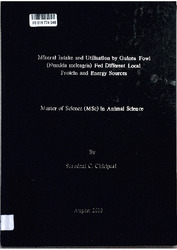| dc.description.abstract | Two studies were carried out to investigate the effects of feeding different locally available protein and energy sources on mineral utilisation by guinea fowl were investigated. In the first study, ninety-six-day old keets were randomly assigned to four dietary treatments being 3% fishmeal (control), 4.5% mopane worm meal, 9% mopane worm meal and 13.5% mopane worm meal. At 7 and 13 weeks of age, blood and faecal samples were collected from randomly selected birds and analysed for minerals. At 13 weeks of age, all birds were sacrificed and bone and meat samples were collected for mineral analyses. Data were regarded as a split plot design and analysed using the General Linear Model Procedures in Statistical Analysis System. Dietary treatment had no significant (P>0.05) effect on bone length. Bone weights for birds fed 9% mopane worm meal and bone widths for birds fed 4.5% mopane worm meal had lower weights (5.9610.2615 g) and widths (5.7910.1225 mm), respectively than other three treatments which did not differ significantly(P>0.05) from each other. Bone mineral composition of guinea fowl fed diets with 4.5% mopane meal had significantly(P<0.05) higher P (353.621 15.62mg/l), Na (1332.961 16.42mg/l) and K (184H 60.13mg/l) contents than other treatment diets where the control and 13.5% mopane worm meal diets did not differ significantly(P>0.05). Generally, meat and blood mineral compositions of guinea fowl fed 4.5% mopane worm meal were higher than those fed 13.5% mopane worm meal diet whilst control and 9% mopane worm meal were the same. Birds fed diets containing mopane worm meal up to 9% generally performed better than fishmeal based diets.In the second study, two hundred and forty day old keets were randomly assigned to four dietary treatments being yellow maize, white sorghum, pearl millet and commercial broiler diet (control). At 6, 12 and 16 weeks of age, bone, blood, meat and faecal samples were collected from randomly selected birds and analysed for minerals. There were no significant differences (P>0.05)among bone length and width of birds fed sorghum, millet, maize or control diets at 6 and 16 weeks of age. Birds fed millet based diet had significantly (P<0.05) higher bone weights (9.35±0.13g) than birds on the other three treatment diets. Bone Na, Mg and K contents decreased by 26%, 27% and 25%, respectively from 6 to 12 weeks of age and thereafter remained constant. Feeding a diet containing millet resulted in higher bone P
(124195.66±1459.25 mg/1) than those fed other treatment diets. Birds fed diet containing sorghum had the lowest Zn (232.66±11.16 mg/L), Mn (18.37±1.31mg/L), Cu (4.49±0.66 mg/L) and Fe (124.61±8.44 mg/L) bone mineral contents compared to those fed other treatment diets. Calcium, Na, K and Mg contents in the meat decreased over time. Birds fed millet diets had significantly (P<0.05) higher blood Ca (291.50± 18.24 mg/L) than birds fed other treatment diets. It was concluded that pearl millet and white sorghum can replace yellow maize in guinea fowl diets without negatively affecting mineral intake, retention and utilisation. | en_US |

